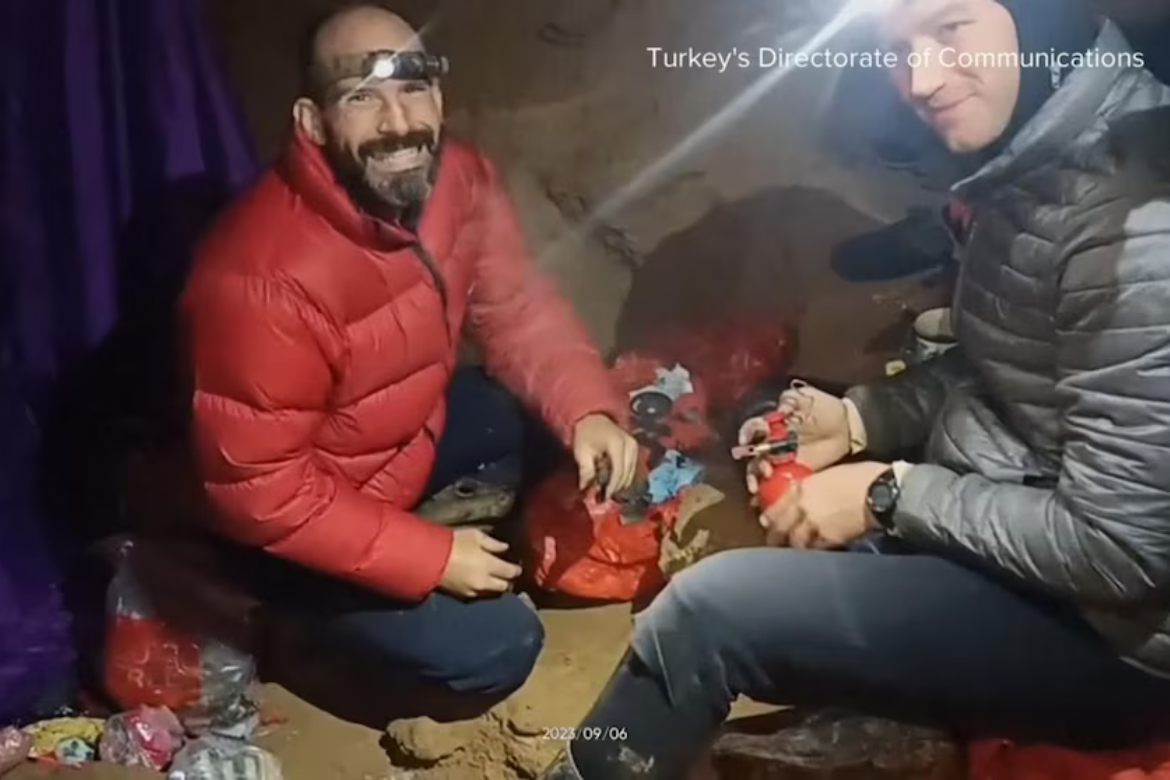Rescuers from across Europe have launched an operation to save an American researcher in Turkey, who became trapped almost 1,000 meters (3,280 feet) below a cave’s entrance after suffering stomach bleeding.
Experienced caver Mark Dickey, 40, suddenly became ill during an expedition with a handful of others, including three other Americans, in the Morca cave in southern Turkey’s Taurus Mountains, the European Association of Cave Rescuers said.
In a video message from inside the cave and made available by Turkey’s communications directorate on Thursday, Dickey thanked the caving community and the Turkish government for their efforts.
“The caving world is a really tightknit group and it’s amazing to see how many people have responded on the surface,” said Dickey. “I do know that the quick response of the Turkish government to get the medical supplies that I need, in my opinion, saved my life. I was very close to the edge.”
Dickey, who is seen standing and moving around in the video, said that while he is alert and talking, he is not “healed on the inside” and will need a lot of help to get out of the cave. Experts said the rescue operation could take days or even weeks depending on conditions.
Dickey, who had been bleeding and losing fluid from his stomach, has stopped vomiting and has eaten for the first time in days, according to a New Jersey-based cave rescue group he is affiliated with. It is unclear what caused his medical issue.
Complicated rescue
The New Jersey Initial Response Team said the rescue will require many teams and constant medical care. The group says the cave is also quite cold – about 4-6 degrees Celsius (39-42 degrees Fahrenheit).
Communication with Dickey takes about five to seven hours and is carried out by runners, who go from Dickey to the camp below the surface where a telephone line to speak with the surface has been set up.
Dinko Novosel, a Croatian cave rescuer who is head of the European Association of Cave Rescuers, said it will be a challenge to successfully rescue Dickey.
The operation to bring him up from the depths involves rescue teams from Bulgaria, Croatia, Hungary, Italy, Poland and Turkey.
Yusuf Ogrenecek, of the Speleological Federation of Turkey, said that Dickey’s condition had stabilised and was improving. He said the American was in “good spirits” and doctors would decide if Dickey could leave the cave on a stretcher or under his own power.
Turkish disaster relief agency AFAD and rescue team UMKE are working with Turkish and international cavers on a plan to hoist Dickey out of the cave system, the rescue association said.
The rescue effort currently involves more than 170 people, including doctors and paramedics who are tending to Dickey, as well as experienced cavers, Ogrenecek said, adding that the rescue operation could take up to two or three weeks.
A team of rescuers from Italy’s National Alpine and Speleological Rescue Team will be flying to Turkey on Thursday night. A total of around 50 rescuers will be at the entrance of the cave early on Friday ready to participate in the operation directed by Turkish authorities.
Marton Kovacs of the Hungarian Cave Rescue Service said that the cave is being prepared for his safe extraction. Narrow passages are being widened to accommodate a stretcher, and the danger of falling rocks is also being addressed.
The rescue teams hope that the extraction can begin on Saturday or Sunday. Kovacs said that lifting Dickey will likely take several days and that several bivouac points are being prepared along the way so that Dickey and rescue teams can rest.
The cave has been divided into several sections, with each country’s rescue team being responsible for one section.
The Hungarian Cave Rescue Service, made up of volunteer rescuers, was the first to arrive at Dickey’s location and provided emergency blood transfusions to stabilize his condition.
‘Highly trained caver and rescuer’
Dickey was described by the European Cave Rescue Association as “a highly trained caver and a cave rescuer himself” who is well known as a cave researcher, or speleologist, from his participation in many international expeditions. He is secretary of the association’s medical committee.
Dickey was on an expedition mapping the 1,276-meter (4,186-feet) deep Morca cave system for the Anatolian Speleology Group Association (ASPEG) when he ran into trouble about 1,000 meters (3,280 feet) down, according to Ogrenecek.
Justin Hanley, a 28-year-old firefighter from near Dallas, Texas, said he met Dickey a few months ago when he took a cave rescue course Dickey taught in Hungary and Croatia. He described Dickey as upbeat and as someone who sees the good in everyone.
“Mark is the guy that should be on that rescue mission that’s leading and consulting and for him to be the one that needs to be rescued is kind of a tragedy in and of itself,” he said.
Hanley said he had talked to Dickey about a month ago about the mission in Turkey and that the aim of the expedition was to survey, collect information and set up camps in the cave.



